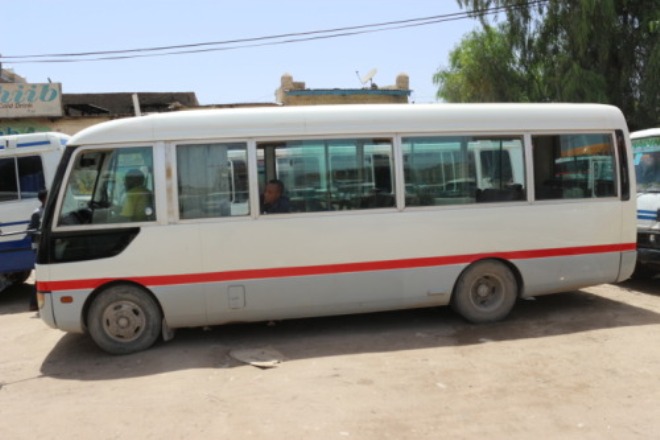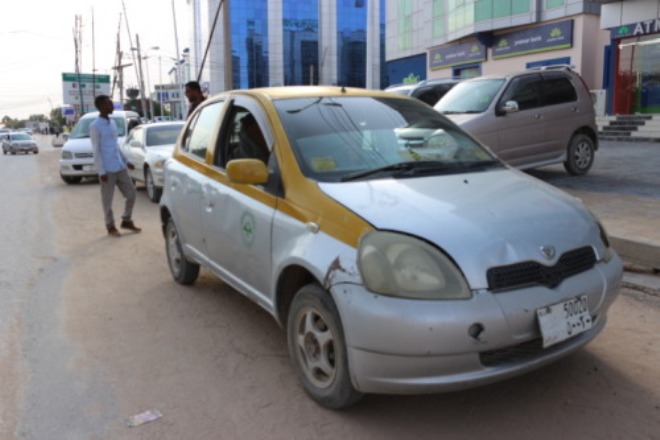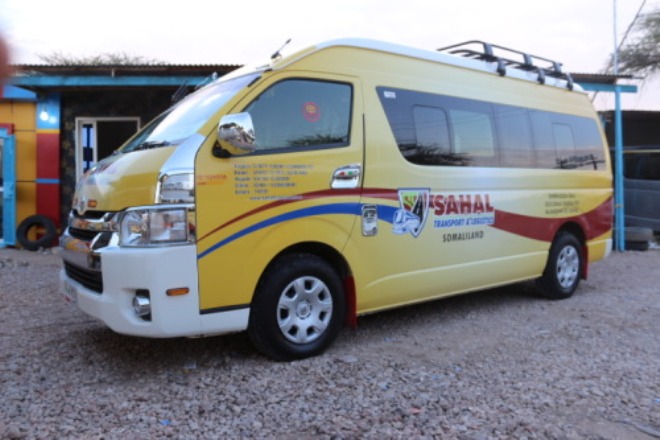Warsame M. Ahmed
Govsea
Saturday July 15, 2017
Sub-standard roads, the pollution and dust of cars, overloaded vehicles, and, of course, the downed MiG-17 fighter jet monument erected in the city center might not be among the best first impressions for Hargeisa.
Yet behind the surface of appearances Somaliland’s capital has a thriving urban transport system. Many urban services in Somaliland are organized informally including, electricity and waste disposals; public transportation is not an exception.
Rapid urbanization and the increased need for mobility have put tremendous pressure on the already poor transport infrastructure in the country. In 2012, Somaliland’s road network was 8,795 km of which 770 km consisted paved roads. As of today, the total paved roads stands at 1010 km, an increase of 240 km. The rest of the roads are either unpaved gravel roads or dirt tracks. Much of the fund for road improvement came from the Somaliland Development Fund (SDF).
Transportation in Somaliland relies on buses, minibuses, taxis, three-wheelers and trucks. The public transport sector, in particular, is dominated by Toyota brands including Coaster, Hiace and Vitz. These cars were originally built in Japan and purchased from Dubia’s Al Aweera Auto Market as second hand cars. Most Somaliland car owners lack the capital to buy a new vehicle and credit facilities are almost non-existent in the country.
Hargeisa is the capital and the main financial and economic hub for Somaliland. More than 30% of the country’s population live in Hargeisa. According to a recent government estimatet, the city has grown to over one million inhabitants. As a result mobility is becoming more inefficient by the day. The reason is a combination of old, un- or underserviced and often heavily banged up buses and a deteriorating road network. In recent years rapid motorization has put pressure on city traffic, particularly during peak hours. Traffic jams test the patience of Somalis whose mind is hardwired to fast mobility.
The number of registered cars in Somaliland has more than doubled in the last six years. In 2010 there were roughly 35,000 privately owned cars in Somaliland, today there are more than 80,000 cars plying the streets of the county and there is no doubt, whatsoever, that large proportion of this vehicles are used in Hargeisa.
Buses
Since 1970’s buses have been the most common means of public transport in Hargiesa. The main bus operator is the Hargeisa City Bus Cooperative or Iskaashatada basas-ka ee Hargeisa, a legacy of the late Siyad Bare’s regime and the (semi-)state cooperatives and voluntarism dating back to the early 1970s. The Hargeisa City Bus Cooperative also provides school bus service. The loosely-knit cooperative was established for the sole purpose of monopolizing control over routes and is still serving that tenacity to this day. The main role of the bus cooperative’s management is to supply new buses, manage queues, resolve conflicts, act as an insurer and negotiate with local authorities.
The cooperative operates along eleven different routes to all the five district of city and six suburbs. During peak hours, they run less than 5 minutes headways in downtown and might take more than an hour during off-peak hours, especially for less travelled routes. There are no fixed schedules as such, but as soon as the bus ahead is full, it leaves, and is replaced by the next one in the queue. According to the cooperative’s own records, its more than 800 registered buses transport over 130,000 passengers every single day. Less populated areas in Hargeisa are served by minibuses and three-wheelers.
This informal public transportation sector provides employment opportunities to a large number of people. Normally, each vehicle employs more than seven individuals including the driver, a fare conductor and touts.

A bus owned by the Hargeisa City Bus Coperative
© Warsame M. Ahmed (2017)
The cooperative operates from a two room office in downtown Hargeisa. Abdirahim Mohamed, who is the current head of the cooperative, is enthusiastic when he talks about their current operations and the future prospect of their business. New to the management, he says that they had already introduced a number of different measures to improve their service. For instance, they started paying taxes, on behalf of their member, to the local government which allows them a better representation and bargaining power. Nevertheless, the cooperatives’ boss identified limited parking area, non-existence of bus stops and the lack of a public transport policy framework as the most important impediments to future growth for the business.
Taxis
A few years ago, a 5 km taxi ride in Hargeisa cost more than 20 USD. Today, even though fares are negotiated, one can travel the same distance for 3 USD or less. Taxis for hire are now becoming an essential part of informal public transport in Hargeisa.
Their growing popularity lies in their ability to provide customers with door−to−door service and to enter narrow alleyways. Taxi business in Hargeisa is not territorial and as such a taxi driver can travel to any district in the city – unlike buses and minibuses. The first company to establish a taxi service in 2011 was Raaxo Taxi Company.
Although the company soon went out of market, the initiative left a lasting effect in the city. Mohamed Hashi, a cofounder of Raaxo, identified a lack of skilled drivers and ostentatious behavior among drivers as main causes forcing them to close business. Today, there are more than 4000 cars offering taxi services to customers in Hargeisa. They are mostly known by their local Somali name ‘tukhaan’, meaning ‘bed bugs’, a nod to their small size and huge number. The ‘bed bugs’ are mostly driven by young men, some of whom are known for their notorious behavior and reckless driving. Most of their clients are students and women.

Taxi in downtown Hargeisa
© Warsame M. Ahmed (2017)
Intercity transportation
Even though Somaliland’s long-distance bus service is not well defined, it can be understood as the maximum route limit between point of origin and destination. Only a few years ago, travelling from Hargeisa to Tog’wajalle located at the Ethiopian-Somaliland border, a 90 kilometers distance, would consume at least four hours of passenger’s time. Nowadays, there are express transportation providers covering all major cities in Somaliland. East and West, Sahal Transport and Logistics and Salaama are among the three most prominent express passenger transportation provides.
Express buses run on a tight schedule, something new to the country. Mohammed Ali, the cofounder and manager of Sahal Transport and Logistics is a former lecturer at a local university and comes from a business family. In the company’s headquarters, Mohamed sits in a neat and elegantly decorated office. He effortlessly describes the humble beginnings of the company and how it started with only 8 used vehicles and 13 staff in 2014.
Since then the venture has grown to 40 vehicles of mostly brand new cars and more than 70 employees. Compared to other express buses, Sahal charges higher fares, but provides additional amenities including internet service, air conditioned interiors, guaranteed seats and a bottle of drinking water. Mohammed appears worried when he describes the challenges his company faces including, unsuitable roads for their brand new vehicles, constant fair of accidents, lack of regulations and the non-existence of insurance service.

Brand new bus owned by Sahal Transport & Logistics
© Warsame M. Ahmed (2017)
Policy issues
The combination of market forces and the lack of an efficient transport system has given rise to an informal transport systems in developing countries. In Somaliland informal transport services are the only bona fide transportation system that is currently available. Informal public transportation has both favorable and unfavorable consequences. On of the positive side, it gives the poor cheap mobility and, be that as it may, the absence of a regulatory framework increases the odds that the poor quality service provided will prevail. For that reason, it is important to address the following issues in order to modernize the sector without compromising some of the positive aspects of informal transportation.
The biggest challenge for vehicles in Somaliland is undoubtedly the neglected road infrastructure. Streets in Hargeisa are, indeed, in bad shape. The streets inside the city and those connecting to suburbs and other cities are rarely rehabilitated. On top of that, the increasing number of vehicles has fueled the wear and tear and worsened road quality. The road damage, which usually starts as a potholes, soon merge together into gaps which grow every day. Vehicles and buses transporting goods and people often veer into pedestrian areas or the opposite traffic lane to avoid these holes, frequently causing serious injuries and damages. A police report published in 2016 puts the number of death and injured due to traffic violation, at 165 and 2043 respectively. This number is much larger than fatalities of murder and conflict combined.
Another important problem is congestion. Street vendors, pedestrians and buses compete over space in downtown Hageisa. As a result the central business district is often in standstill, blocking all mobility. The worst affected areas are those near bus stops and junctions. This problem can be addressed by allocating off-road terminals and bus stops. Lastly, political leadership and commitment to improved road infrastructure and regulatory framework for public transportation are necessary, if not indispensable, to tackle the poor service provision, unsafe driving, overload and other malpractices.
Warsame M. Ahmed is the Director of Research and Community Service and a Senior Lecturer at University of Hargeisa. He is an economist by training. His research focuses on urban informal economy, crime, cross border trade and institutions in economic development.